Table of Contents
Humanoid robots struggle with balance because gravity’s a brutal dance partner. We’ve watched countless robots topple like drunk jenga towers, all because maintaining stability is crazy complex. Engineers fight back with hyper-sensitive sensors, adaptive algorithms, and biomimetic control systems that calculate ground forces and adjust millisecond-by-millisecond. Think of it like giving robots superhuman reflexes—they’re learning to stay upright by predicting and countering every potential tumble. Curious how they’ll nail it?
The Physics of Falling: Understanding Bipedal Instability
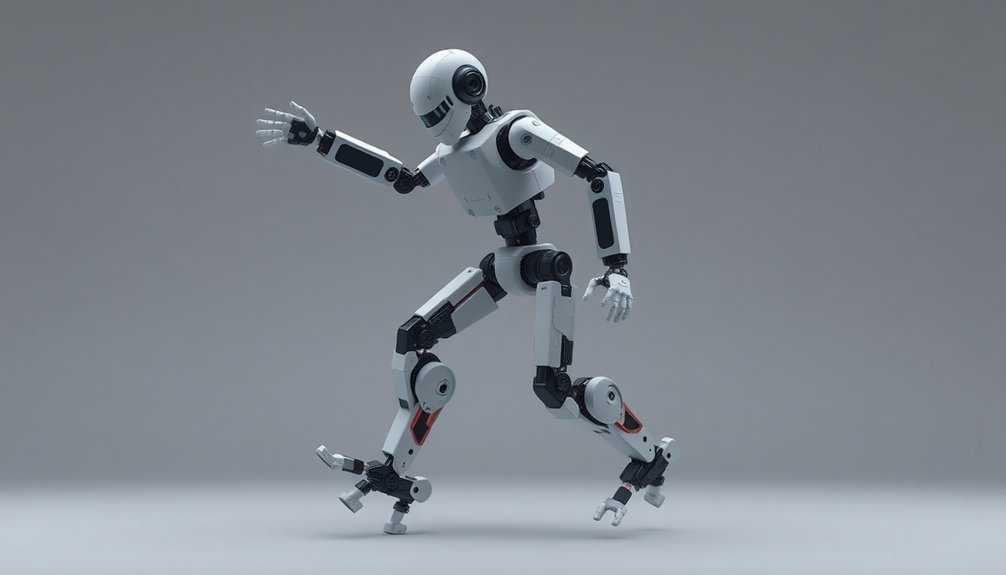
When it comes to robots walking on two legs, staying upright isn’t as simple as we might think. Bipedal dynamics are a complex dance of physics, balance, and split-second corrections. These machines navigate through hybrid phases—single support, double support—like tightrope walkers with mathematical brains. Imagine trying to balance a pencil on its tip while someone randomly nudges your elbow; that’s basically what robotic engineers are up against. Underactuation means these robots have more potential movement than actual control, making stability a constant high-wire act. Proprioceptive sensors help robots understand their body positioning and enhance balance during complex movements. Each step involves managing non-smooth dynamics, where sudden ground impacts can send a robot tumbling faster than you can say “calibration error”. By utilizing a center of mass trajectory predictive control system, engineers can mathematically anticipate and mitigate potential balance disruptions. It’s not just walking—it’s controlled falling, with mathematical precision.
Center of Mass: The Invisible Balance Point
Picture a robot on the verge of a spectacular wipeout—its fate hanging by a mathematical thread. The center of mass is like a robot’s invisible balancing point, the secret sauce between staying upright or face-planting dramatically. It’s where all the robot’s weight technically concentrates, making motion stability a high-wire act of engineering genius. Sensor fusion techniques from advanced robotic systems help engineers continuously recalibrate and stabilize a robot’s precarious balance.
Every tiny shift can mean the difference between a graceful stride and an embarrassing tumble. Humanoid robots struggle with this delicate dance because their center of mass sits high and precariously, unlike humans who’ve had millions of years to perfect balance.
Engineers are basically robot choreographers, constantly calculating and adjusting this invisible point to keep their mechanical dancers from crashing to the ground. It’s complex physics meets pure mechanical poetry.
Gravity’s Challenge: Why Humanoid Robots Struggle to Stand
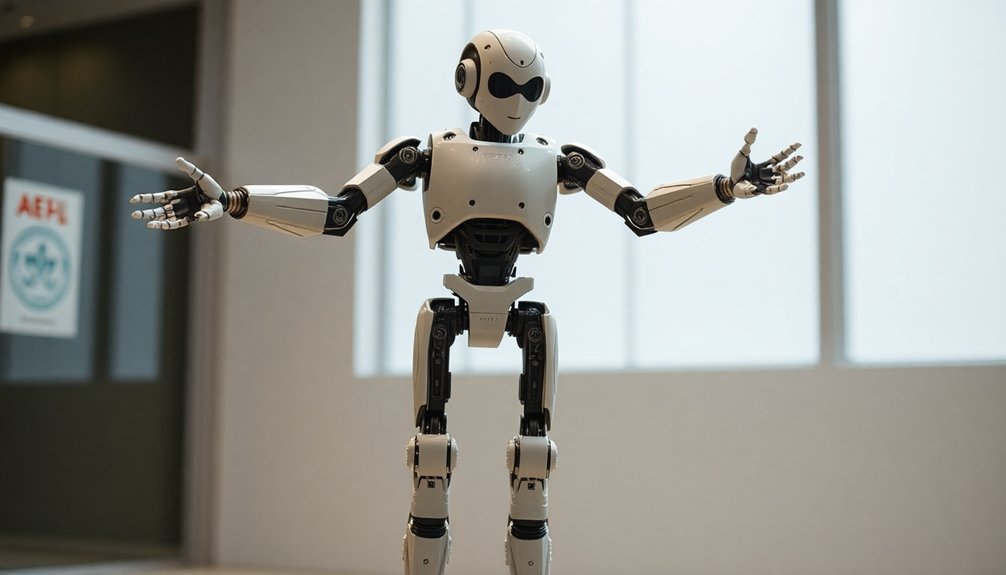
Because gravity’s a merciless jerk, humanoid robots face an epic battle just staying vertical. The gravitational impact on these mechanical marvels is no joke. Every step is a calculated dance against toppling over, with engineers wrestling complex challenges of weight distribution:
Gravity’s relentless challenge: humanoid robots battling vertical survival through precision engineering and dynamic balance.
- Managing inertia like a high-stakes balancing act
- Designing actuators strong enough to push back against Earth’s constant pull
- Integrating hyper-sensitive sensors that catch the slightest wobble
- Programming adaptive algorithms that predict and prevent falls milliseconds before they happen
We’ve watched countless robots stumble and crash, but each failure teaches us something new. It’s not just about building a machine that stands—it’s about creating a system that thinks about balance the way a tightrope walker does: constantly, dynamically, and with near-superhuman precision. The Center of Mass control techniques developed by roboticists provide critical mathematical strategies for maintaining stability across complex mechanical systems. Remarkably, the hip joint dynamics play a crucial role in translating robotic movement from theoretical design to practical execution. Feedback loop mechanisms enable robots to make split-second corrections, transforming potential falls into moments of adaptive brilliance.
Hip and Ankle: Engineering Strategies for Robotic Balance
We’ve all seen robots wobble like toddlers learning to walk, but their balance isn’t random—it’s a carefully engineered dance between hip and ankle movements. Sensor technologies like accelerometers and gyroscopes play a crucial role in detecting and responding to balance disruptions. Engineers are developing advanced control algorithms that use virtual forces to help humanoid robots maintain stability during unexpected disturbances. Our robotic friends are developing strategies to stay upright, using sophisticated control techniques that mimic how humans instinctively adjust their body to prevent falling. Recent research demonstrates that robots can now utilize Model Predictive Control frameworks integrating multiple balancing strategies to significantly improve their stability across complex dynamic environments.
Balancing Through Hip
When humanoid robots try to stay upright, their hip joints become the unsung heroes of balance—complex mechanical marvels that translate engineering precision into something that almost looks like grace. Active balance control mechanisms provide crucial stability by dynamically adjusting hip movements to maintain the robot’s equilibrium. Static inversion point modeling enables robots to predict and counteract potential balance disruptions by analyzing center of mass trajectories and energy conservation principles. Torque sensors capture nuanced mechanical feedback, allowing robotic joints to simulate the responsive precision of biological muscle movement.
Hip stability isn’t just a technical challenge; it’s a dance of physics and mechanics.
We’ve discovered that conquering torque challenges requires some seriously.
Ankle Control Techniques
If the hip is the balancing ballet dancer, then the ankle is the unsung choreographer of robotic movement.
When it comes to keeping humanoid robots upright, ankle mechanisms are doing serious heavy lifting. We’re talking about intricate designs that manage complex torque requirements while staying slim and nimble.
Smart engineers use cable-based actuation and innovative compliance adjustment techniques to prevent these mechanical friends from face-planting. Pneumatic muscle actuators and advanced control algorithms let robots shift weight like professional tightrope walkers.
Think of it as giving robots superhuman balance—they can adjust stiffness mid-step, compensate for uneven terrain, and recover from unexpected pushes.
Four-bar linkage design allows precise ankle pitch control, enabling more stable and nuanced robotic movement.
Actuator innovations mean these mechanical limbs are getting smarter, lighter, and more responsive.
Who knew robot ankles could be so fascinating?
Control Systems: Precision Technology Behind Robot Stability
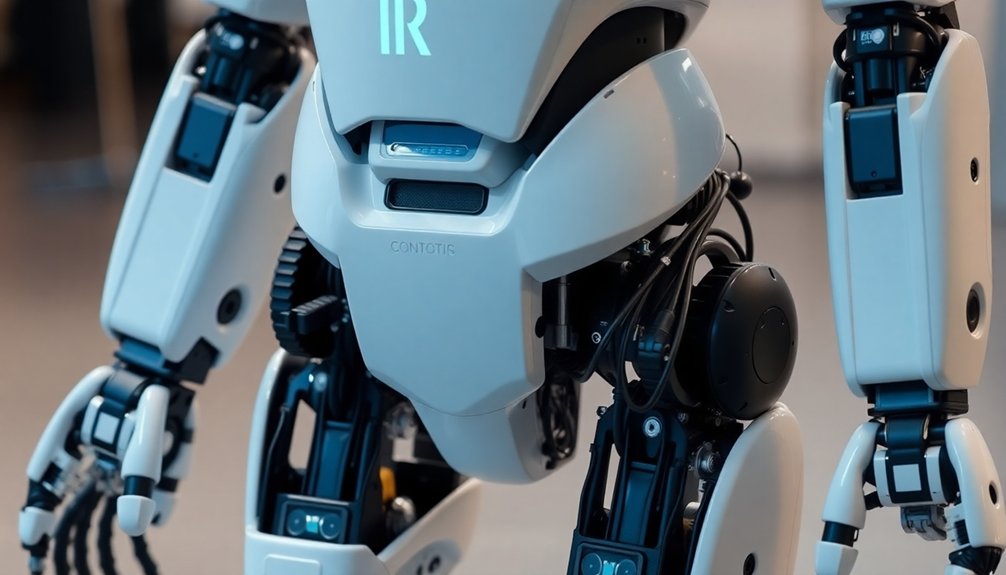
We’ve figured out that keeping robots upright isn’t just about fancy math—it’s about understanding how they move and react in real-world chaos.
The Zero Moment Point lets us predict where a robot might tip over, while adaptive control systems act like a digital inner ear, constantly adjusting to maintain balance.
Our most promising breakthrough? Dynamic movement stabilization, which fundamentally teaches robots to catch themselves before they fall, just like humans do when they stumble. Through whole-body capturability, we can now optimize a robot’s ability to respond to sudden external forces by incorporating complete body dynamics into its balance strategy. GaN technology enables high-speed motor control loops that enhance precision and stabilization in robotic movement.
Zero Moment Point
Because robots aren’t exactly known for their grace, engineers had to get seriously clever about keeping them upright. We’ve cracked the code with ZMP algorithms that track bipedal dynamics like a hawk.
Our solution? The Zero Moment Point (ZMP) strategy, which basically turns robot stability into a high-stakes balancing act:
- Measure ground reaction forces precisely
- Calculate the exact point of zero moment
- Keep the robot’s center of mass within its support base
- Adjust in milliseconds to prevent spectacular face-plants
Adaptive Control Systems
Where ZMP tracking leaves off, adaptive control systems kick into high gear.
We’re talking about robot brains that learn on the fly, dynamically adjusting parameters to keep our mechanical friends upright. Think of it like a gymnast constantly recalibrating mid-flip—that’s adaptive parameter estimation in action.
Model reference control lets robots compare their actual movement to an ideal path, then make split-second corrections. It’s not just about preventing falls; it’s about creating robots that can dance through unpredictable environments.
By rewriting motion equations and constantly estimating dynamic parameters, these systems turn clunky machines into agile performers.
Who wouldn’t want a robot that doesn’t just stumble around like a drunk uncle at a wedding, but moves with precision and grace?
Dynamic Movement Stabilization
When humanoid robots dance along the razor’s edge between graceful movement and catastrophic face-plant, dynamic movement stabilization becomes the unsung hero of robotic engineering.
Our quest for dynamic adaptation involves complex strategies that keep robots upright and moving:
- Real-time balance adjustments track unexpected forces
- Advanced control systems predict and counteract potential falls
- Biomechanical-inspired controllers mimic human reflexes
- Neural network policies enable lightning-fast stability enhancement
We’re basically teaching robots to have superhuman reflexes.
Imagine a robot that can recover from a shove faster than a caffeinated ninja—that’s the magic of dynamic movement stabilization.
These aren’t just algorithms; they’re the digital equivalent of a robot’s inner ear, constantly calculating, adjusting, and preventing what would otherwise be an embarrassing tumble into technological humiliation.
Advanced Movement: Navigating Dynamic Environments
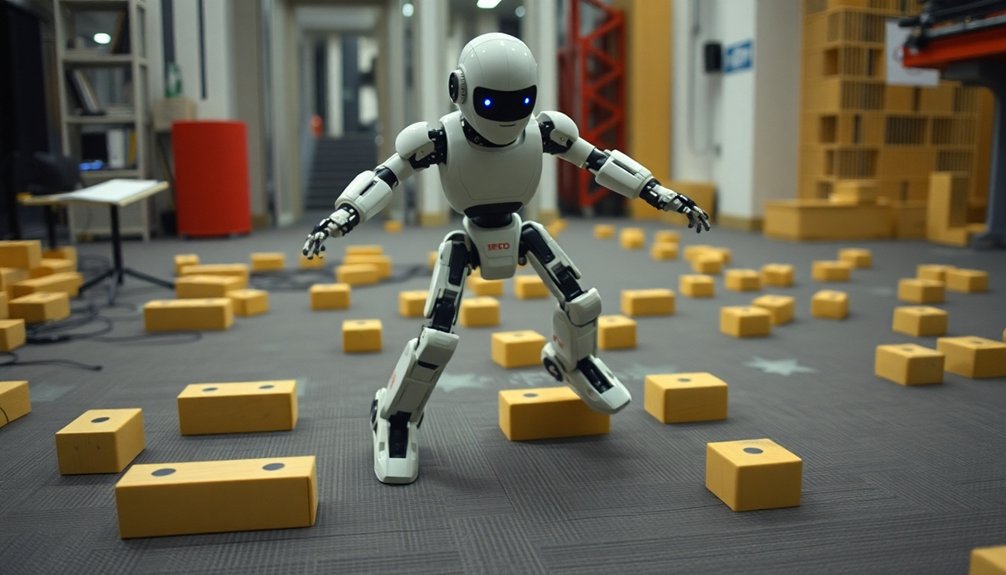
If maneuvering dynamic environments were easy, we’d already have robot butlers serving martinis in every living room.
Dynamic obstacle navigation isn’t just about avoiding chairs—it’s about understanding complex social spaces. We’re teaching robots to read emotional cues and predict human movement, which means developing systems that are part navigation, part mind-reading.
Emotion-aware navigation lets robots anticipate a person’s next step before they take it, like a dance partner who always knows the next move. Our algorithms use deep reinforcement learning to help robots adapt in real-time, processing sensor data faster than you can blink.
The goal? Robots that move through crowded spaces as smoothly as a seasoned New Yorker during rush hour—predicting, adjusting, never breaking stride.
Breakthrough Technologies Transforming Robot Stability
Because robots have historically been about as graceful as a toddler on roller skates, breakthrough technologies are finally making humanoid machines that can actually stay upright.
We’re seeing major leaps in robot stability through innovative approaches like:
- Advanced robot learning frameworks that teach machines how to maintain balance
- Cutting-edge sensor technology enabling real-time environmental perception
- Algorithmic improvements for smoother, more predictable movements
- Simulated training environments that prepare robots for complex scenarios
From Laboratory to Real-World: Solving Complex Balance Problems
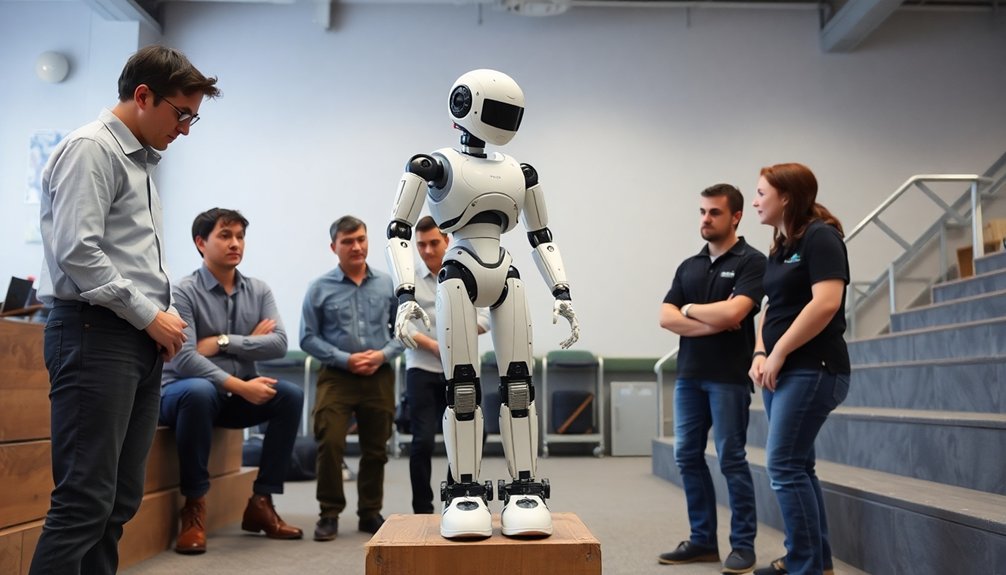
Despite countless YouTube videos of robots stumbling like drunk uncles at a wedding, scientists are finally cracking the code of humanoid stability. Real-world integration demands more than lab perfection—it requires robustness testing that pushes technological limits.
| Challenge | Innovative Solution |
|---|---|
| Environmental Uncertainty | Adaptive Motion Policies |
| Sensor Noise | Advanced Filtering Techniques |
| Dynamic Forces | Predictive Control Algorithms |
We’re teaching robots to dance through chaos by simulating unpredictable scenarios. Machine learning models now train on everything from subtle floor vibrations to violent shoves. The goal? Robots that don’t just survive disruptions but anticipate and neutralize them. Imagine humanoid machines that can catch themselves mid-fall, adjusting posture faster than a cat—not just surviving, but thriving in messy, uncontrolled environments. The future of robotics isn’t about avoiding failure; it’s about transforming potential disaster into graceful recovery.
People Also Ask
Can Humanoid Robots Ever Truly Match Human-Like Balance Capabilities?
We’re pushing the boundaries of balance algorithms and sensory integration, but genuinely matching human-like balance remains a complex challenge requiring breakthrough innovations in robotic adaptability and responsive movement.
How Expensive Are the Advanced Control Systems for Robotic Stability?
Rome wasn’t built in a day, and neither are advanced robotic control systems. We’re looking at $1,100 to $1,650 for motion control, with cutting-edge technologies driving robotic stability advancements at significant computational and financial investments.
Are Bipedal Robots More Dangerous When They Lose Balance?
It is understood that bipedal robots can become dangerous when they lose balance, as their robotic falls pose significant risks to humans and surrounding equipment due to unpredictable balance techniques and potential high-velocity impacts.
What Fundamental Physical Limitations Prevent Perfect Robotic Balance?
We’ve found that only 0.02% of humanoid robots maintain perfect balance due to complex leg movement dynamics and center gravity analysis challenges in adapting to rapid environmental changes and unpredictable weight distribution.
Do Different Robot Sizes Dramatically Impact Stability Challenges?
We’ve discovered that robot proportions dramatically influence stability factors, with smaller robots requiring more sophisticated control systems and larger robots facing center of mass challenges during movement.
The Bottom Line
We’re pushing the boundaries of robotics, one wobbly step at a time. Imagine a rescue bot like Boston Dynamics’ Atlas maneuvering a collapsed building, perfectly balanced where humans would stumble. Our quest isn’t just about preventing robot falls—it’s about creating machines that can move with human-like grace and resilience. The future isn’t about perfection, but intelligent adaptation. And that’s something worth getting excited about.
References
- https://imsystems.nl/challenges-in-building-humanoid-joints-part-1-legs-balance/
- https://imsystems.nl/advanced-actuator-strategies-for-humanoid-robot-balance/
- https://asmedigitalcollection.asme.org/mechanismsrobotics/article/16/1/011005/1159763/Partition-Aware-Stability-Control-for-Humanoid
- https://www.tandfonline.com/doi/abs/10.1080/01691864.2021.1959398
- https://www.mdpi.com/2075-1702/10/6/463
- https://research.tue.nl/files/3772226/773048.pdf
- https://www.degruyterbrill.com/document/doi/10.1515/phys-2020-0148/html?lang=en
- https://ietresearch.onlinelibrary.wiley.com/doi/10.1049/cim2.12080
- https://crablab.gatech.edu/pages/publications/pdf/KINGSBURY-DISSERTATION-2016.pdf
- https://www.cs.cmu.edu/~cga/legs/reflexes.pdf